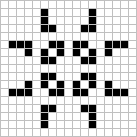Description
Conway's Game of Life is a classic example of cellular automata. The game plays out on a rectangular grid with each cell on the grid starting as either "dead" or "alive" when the game begins. On the next iteration of the game (called a "generation") the cells are updated according to this surrounding neighbors, defined by the 8 cells positioned around each square:
- Birth: A dead cell comes to life if it has exactly 3 live neighbors.
- Survival: A living cell stays alive if it has 2 or 3 live neighbors.
- Death: A cell dies if it has less than 2 neighbors (solitude) or more than 3 neighbors (overpopulation).
This simple simulation demonstrates how complex structures can arise out of simple rules. When Conway's Game of Life was published in October 1970's Scientific American, it attracted the attention of computer scientists, biologists, mathematicians, and philosophers who pondered on the implication that "design" and "organization" can spontaneously emerge in the absence of a designer.





